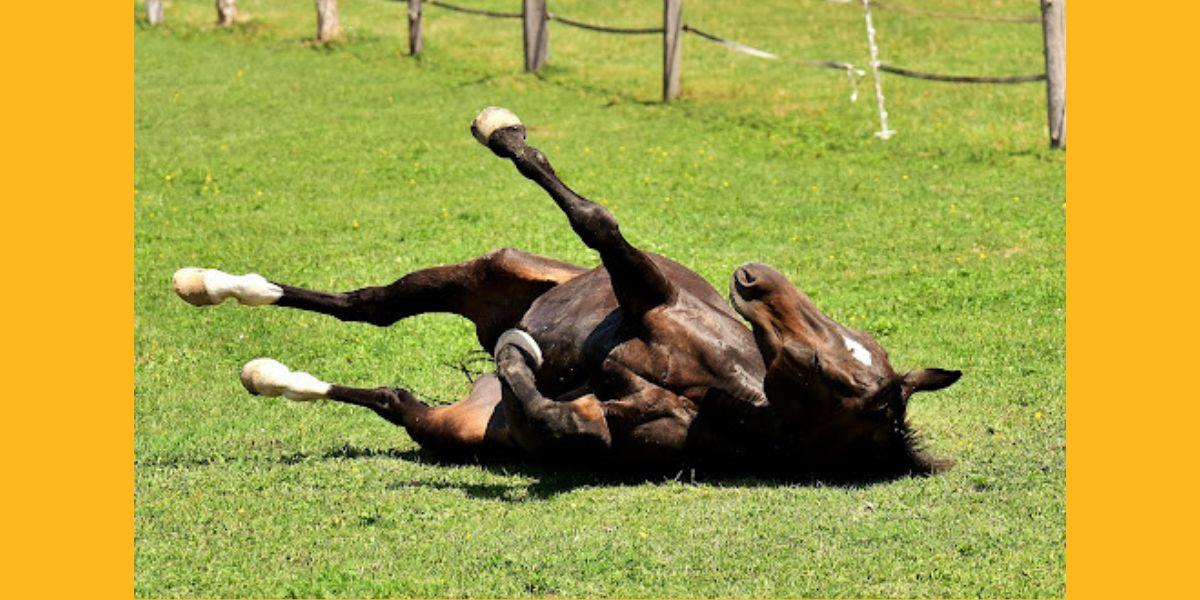Fluid check
New research focused on improving health outcomes following colic surgery

New research focused on improving health outcomes following colic surgery
A horse rolls on the ground, often an indicator of a case of colic.
Drs. Jenna Young and Troy Trumble recently received funding to find ways to reduce the need for a second surgery in horses who develop recurring abdominal pain following initial colic surgery.
The American College of Veterinary Surgeons Diplomate Research Grant Program and the University of Minnesota CVM Resident & Graduate Student Research Grants awarded the funds.

Their research will measure certain indicators in fluid from the abdominal cavity before the initial surgery and at set points in time following surgery to determine if the fluid markers correlate with health outcomes. The levels will help veterinarians decide whether the recurrent colic pain stems from a complication that requires follow-up surgery or if it will resolve without surgery.
“Understanding how to interpret these fluid values postoperatively may allow clinicians to better determine which horses need to undergo a second surgery and potentially avoid surgery in others, ultimately increasing survival rates in this population of horses,” Young says.
Colic is a general term used to describe abdominal distress in horses. The condition stems from one of a number of different sources—a twisted or blocked intestine, build-up of gas, inflammation of the lining of the gut, or displacement or entrapment of bowel—to name just a few. Very painful and, possibly, life-threatening, colic is a common cause for on-farm visits by veterinarians and is the most common cause of death in horses ages 1 to 20 years old.

Quick action is often needed to treat horses with colic, but determining the cause of the pain and the best course of treatment can be very challenging for veterinarians. Most cases of colic are resolved with medical therapy however, sometimes, surgery is needed to manage a horse with colic. The number of colic cases requiring surgery ranges from 2 to 10%.
Recent advances in equine surgery have improved short-term and long-term survival rates from colic surgery to more than 80 percent for those that recover from anesthesia. However, the most common complication following surgery is recurrent colic with 28 to 30 percent of horses experiencing abdominal pain postoperatively. Determining the cause of this recurrent pain and the need to perform a second surgery can be a diagnostic conundrum for clinicians.
One method veterinarians commonly use to determine if a horse with colic requires surgery initially is to obtain fluid from the cavity between the abdominal wall and the body organs. This fluid, the peritoneal fluid, gives clues about what may be causing the colic.
In a healthy horse, this fluid is clear to light yellow, odorless, and transparent. Peritoneal fluid collected from a horse with colic may have a different color or smell and may appear cloudy. Additionally, horses with colic may have higher or lower levels of certain cells or fluid markers in the peritoneal fluid.
Any change in the fluid gives the veterinarian information about the source of the colic and allows for a more accurate diagnosis, prognosis, and treatment. While all this information is known about how to interpret peritoneal fluid in a horse initially presenting for colic, there is little information on how to interpret this fluid after a horse has undergone colic surgery.
In their study, Young and Trumble will study the peritoneal fluid of horses that have undergone colic surgery to determine the levels of different cells and fluid markers postoperatively at multiple time points. They will examine how changes in these levels relate to the horse’s outcome following surgery.

“The ability to use peritoneal fluid to diagnose recurring abdominal pain following surgery is much more cost-effective for owners and, it is safer for the horse than undergoing additional anesthesia and a second surgery, ” Young says.
The long-term survival rate of horses that undergo two or more consecutive colic surgeries is poor at 22 percent.
Assisting Young and Trumble with the research will be Dr. Maria Granello, a large animal surgery resident. Granello has been involved in the study design and grant writing and will be intricately involved in the data collection process.